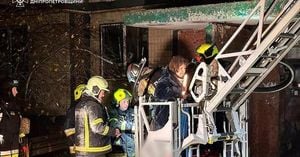On October 18, 2025, a wave of protest swept across the United States as millions gathered for the "No Kings" rallies—a nationwide movement decrying what demonstrators describe as the creeping authoritarianism of President Donald Trump’s second term. From the sun-drenched lawns of Beverly Hills’ Roxbury Park to the chilly streets of Brunswick, Maine, and the riverside walkways of Middletown, Connecticut, Americans from all walks of life stood shoulder to shoulder, united by a single, resonant message: no president, no matter how powerful, stands above democracy.
According to reports from The Bowdoin Orient and The Wesleyan Argus, over seven million people participated in more than 2,700 events nationwide, a turnout that surpassed the four to six million who attended the inaugural June protest. In Los Angeles County alone, thirty rallies took place, with the Beverly Hills demonstration drawing more than 3,000 people—stretching from Roxbury Drive to Spalding Drive along Olympic Boulevard. “We had over 3,000 people who were so happy to be there,” said Gay Abrams, one of the Beverly Hills organizers, as quoted by the Beverly Hills Courier. “They came to voice their concerns about what’s happening in this country, and to stand up to what we see is an authoritarian regime and an attack on our Constitution, on our rights, an attack on our decency and our democracy, an attack on immigrants.”
The origins of the "No Kings" movement date back to the summer of 2025, just months after President Trump’s second inauguration. The first protest erupted on June 14—Trump’s birthday—serving as a counterpoint to a military parade in Washington, D.C. Since then, the movement has grown rapidly, culminating in the October 18 mass mobilization. In Maine, the significance of the date was not lost on protesters: it marked the 250th anniversary of the Burning of Falmouth, a pivotal event in the American Revolution. As one attendee, Harper Stevenson, put it in an email to The Bowdoin Orient, “The ‘No Kings’ message is simple—the United States has always been a country that rejects authoritarian rule, and this message gets at the heart of what Trump is doing as he installs himself as a fascist dictator.”
Across the country, the protests were marked by a spirit of peaceful defiance. Indivisible, the grassroots progressive group at the heart of the organizing effort, reported that over 10,000 individuals had been trained in de-escalation techniques. In Middletown, Connecticut, hundreds gathered at Harbor Park, holding signs with slogans such as “My Favorite Season: The Fall of Fascism” and “Hate Won’t Make the U.S. Great.” Connecticut State Senator Matt Lesser and interim Mayor Gene Nocera addressed the crowd, while Rev. Edward Ford Jr. spoke of the importance of advocacy and justice. “The energy is really powerful,” Ford said, according to The Wesleyan Argus. “I think that it’s exciting to see so many people who are pro-democracy, who really want to see our values, our rights, equity and justice continue in this country when those things are being trampled on.”
Participants spanned generations, backgrounds, and political affiliations, though some noted gaps in representation. In Brunswick, Maine, Stevenson observed that, “The majority of protesters were adults or retirees, and a good number of families with their children. There was much less student [or] Gen Z representation than I would have imagined, which I found troubling.” Beth Leonard, co-owner of Gulf of Maine Books, urged younger citizens to get involved: “If you can register in Maine, you should vote in Maine.”
The movement’s name—a direct rebuke of monarchical rule—reflects the protesters’ view that the Trump administration’s recent actions echo the playbook of dictators past. Recent weeks have seen a flurry of controversial decisions: mass Immigration and Customs Enforcement (ICE) raids in Los Angeles County, the deployment of federal troops in major cities such as Washington, D.C., Chicago, Los Angeles, and Portland, and the selective cutting of federal funding, with exceptions carved out for military pay and spending in Republican-led states. The administration has also rolled back vaccine requirements, cut health care funding, and, in a move that particularly irked higher education advocates, threatened to restrict federal funds to universities unless they align with the president’s worldview—stripping diversity, inclusion, and equity efforts from college programs, as reported by Thunderword.
As the protests gained momentum, the White House responded in a manner that further fueled the controversy. According to Thunderword, the administration reposted an AI-generated video depicting President Trump as a monarch, flying a plane and dumping human feces on the American people—a move that many saw as both provocative and emblematic of the administration’s approach to dissent. It wasn’t the first time Trump had been depicted as a king by his own team, but the symbolism was not lost on demonstrators, who held signs reading “Democracy doesn’t fear protest. Dictators do,” and “Trump is the real paid insurrectionist.”
Despite the scale of the protests, organizers and attendees emphasized their commitment to nonviolence. Beverly Hills Vice Mayor Craig Corman and Councilmember Mary Wells attended the local rally, with Corman telling the Beverly Hills Courier, “I was happy to come out and support so many of our residents as they exercised their constitutional right to peacefully protest. I believe last Saturday’s demonstrations across the country and around the globe drew critical attention to recent actions by the current administration that all of us should find deeply concerning.” Around 20 counter-protesters appeared at the Beverly Hills event, but any tensions were quickly deescalated by organizers and local police.
For many, the protests were as much about hope and solidarity as they were about outrage. “It was a really diverse crowd coming together,” said Andrea Grossman, a Beverly Hills resident and co-organizer. “You had people from all sorts of ethnic groups, all sorts of ages. … People showed up to say, ‘This is not the America that I want to see for my future.’”
Others, like Dean Krupa, a candidate for the Middletown Board of Education and Navy veteran, saw the event as a call to civic duty. “I was born in this community. My parents were born in this community. And I just really don’t know how to describe how upset I am seeing our current leadership in office… This is a chance to come out, not really wave a flag or a sign but just show that I’m watching, I’m available, and, when the need arises, I would be willing to participate. I guess this is the start. We have to get out of our houses and into things like this.”
As the sun set on October 18, the #NoKings hashtag trended on social media, with organizers urging participants to share their stories and keep the momentum alive. “We are building momentum, and we’re not going to stop,” Abrams declared. “We’re going to peacefully and nonviolently continue to resist this authoritarian regime, authoritarian administration, and we’re going to continue to do it in Beverly Hills.”
With millions mobilized and the movement showing no signs of slowing, the “No Kings” protests have become a defining feature of the American political landscape in 2025, a testament to democracy’s enduring power—and the people’s willingness to defend it, come what may.






